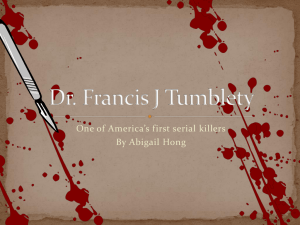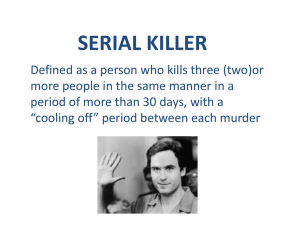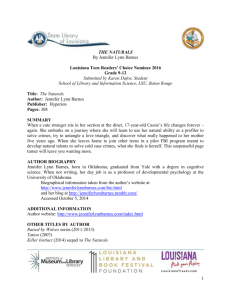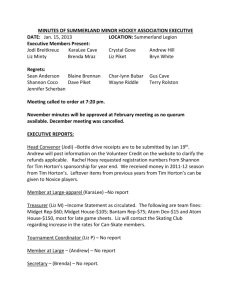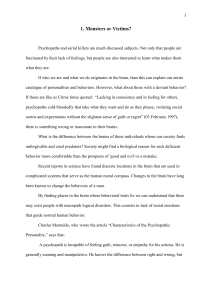2. Studying the Serial Killer Brain - Academic
advertisement
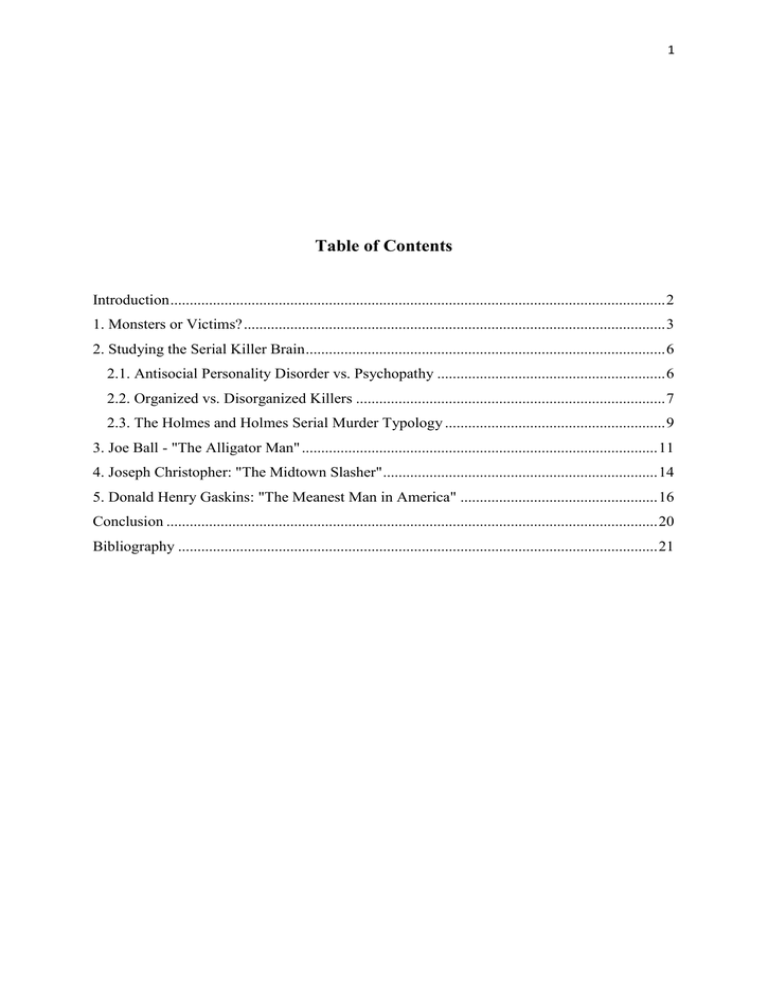
1 Table of Contents Introduction ................................................................................................................................ 2 1. Monsters or Victims? ............................................................................................................. 3 2. Studying the Serial Killer Brain ............................................................................................. 6 2.1. Antisocial Personality Disorder vs. Psychopathy ........................................................... 6 2.2. Organized vs. Disorganized Killers ................................................................................ 7 2.3. The Holmes and Holmes Serial Murder Typology ......................................................... 9 3. Joe Ball - "The Alligator Man" ............................................................................................ 11 4. Joseph Christopher: "The Midtown Slasher" ....................................................................... 14 5. Donald Henry Gaskins: "The Meanest Man in America" ................................................... 16 Conclusion ............................................................................................................................... 20 Bibliography ............................................................................................................................ 21 2 Introduction A serial killer is traditionally defined as a person who has killed three or more people over a period of more than a month, with down time between the murders, and whose motivation for killing is usually based on psychological gratification. Serial killers are not the same; they are classified in many categories. They can kill because of the traumas from their childhood or because of a problem of their brains. This subject is of interest because people should be informed about the problems that can affect the human brain, or the family problems that can make a human become a serial killer. The paper contains 5 chapters. The first chapter “Monsters or Victims?” will solve the mystery of the serial killers brains. It will explain how a serial killer’s brain works and what is wrong with it. The second chapter in entitled “Studying the Serial Killer Brain “and is divided into 3 subchapters: “Antisocial Personality Disorder vs. Psychopathy”, “Organized vs. Disorganized Killers” and “The Holmes and Holmes Serial Murder Typology” which divide Serial killers into more categories. The third chapter “Joe Ball - "The Alligator Man" tells us a story about a man with a sad childhood. The fourth chapter entitled “Joseph Christopher - "The Midtown Slasher" gives us another example of an obsessed serial killer who killed many innocent victims without any reason. The last chapter “Donald Henry Gaskins": The Meanest Man in America" tells us about a coldblooded killer named Pee Wee or The Meanest Man in America who destroyed approximate 181 lives with his brutality. 3 1. Monsters or Victims? Psychopaths and serial killers are much discussed subjects. Not only that people are fascinated by their lack of feelings, but people are also interested to learn what makes them what they are. If who we are and what we do originates in the brain, than this can explain our entire catalogue of personalities and behaviors. However, what about those with a deviant behavior? If those are like as Crime times quoted: Lacking in conscience and in feeling for others, psychopaths cold-bloodedly that take what they want and do as they please, violating social norms and expectations without the slightest sense of guilt or regret” (03 February 1997), There is something wrong or inaccurate in their brains. What is the difference between the brains of these individuals whom our society finds unforgivable and cruel predators? Society might find a biological reason for such deficient behavior more comfortable than the prospects of 'good and evil' or a mistake. Recent reports in science have found discrete locations in the brain that are used in complicated systems that serve as the human moral compass. Changes in the brain have long been known to change the behaviors of a man. By finding places in the brain where behavioral traits lie we can understand that there may exist people with neuropath logical disorders. This consists in lack of social emotions that guide normal human behavior. Charles Montaldo, who wrote the article “Characteristics of the Psychopathic Personality,” says that: 4 A psychopath is incapable of feeling guilt, remorse, or empathy for his actions. He is generally cunning and manipulative. He knows the difference between right and wrong, but dismisses it as not applying to him. A psychopath is also incapable of feeling normal emotions like love, and often shows extreme egocentric and narcissistic behavior. Current research indicates that the serial killer has difficulty actually in processing, understanding and using emotional material general. The material varies from tested emotionally pictures in disturbing to simply emotional words. Noting that the right hemisphere of the brain is specialized for processing the emotional significance of words, researchers speculated that "psychopaths, who are unempathic, callous, and emotionally shallow, would rely less than non- -based decoding strategies. This would mean that repeated stressors may induce an initial minor depression in vulnerable persons. This theory seems to be able to explain the escalating pattern of killings, the relief that some murderers feel after the killing, the quickening of the cycle, and the outof-control feelings. It may be that some serial killers have an unrecognized, aberrant, or atypical form of mood disorder. Hormonal factors could also be a reason. Androgens, like other hormones, may either have a direct influence on physiological mechanisms governing behavior or organize the 5 developing human brain to make particular behavioral responses more likely. Females exposed to excess androgenic activity show male characteristics such as increased aggression. Yet, prenatal exposure to androgens may also cause the same behaviors. Biology support the fact that these individuals suffer from something as simple as a birth defect, or something strange that has happened to or been transcribed in their brains. Changes or abnormalities in the brain, as exposed above, indicate that serial killers do not understand the world as us. As Marquis de Sade said „Their wrong is Nature's too; they are no more responsible for having come into the world with tendencies unlike ours than are we for being born bandylegged or well-proportioned" 6 2. Studying the Serial Killer Brain 2.1. Antisocial Personality Disorder vs. Psychopathy Mental health professionals refer to the (DSM) Diagnostic and Statistical Manual of Mental Disorders, to help guide in the treatment of their patients. It describes antisocial personality disorder, or ASPD. This condition describes many serial killers. The most obvious indicator of the disorder is a total disregard for laws and the social norm. People with personality disorder usually have a long history of arrests and are often involved in physical fights. Some are capable of lying so skillfully it's hard to know when they are telling the truth. They will also act impulsively, with little care to the safety of themselves or others. Symptoms sometimes begin to appear in their early teens. Experts describe psychopathy as a severe form of personality disorder. The difference is, psychopaths have the antisocial behaviors mentioned, but also have additional traits such as lack of remorse or guilt for their actions. They also tend to be highly paranoid, and suspicious. Most psychopaths are not violent or destined to commit murder. A few, however, are at the far end of the scale and are violent. This group may include serial killers. Osterburg and Ward said “Psychopathic serial killers are, almost without exception, males who are driven by a sexual or aggressive drive to exert power and control by killing another living, breathing thing” (40). John Douglas explained in his book, The Mind hunter, that most serial killers are not psychotic. “Psychotic” implies that a person has a psychosis that has caused him to lose touch with reality, and have episodes like hearing voices or delusional behavior, and serial killers do not have this condition. He says that “serial killers are psychopaths who suffer from chronic mental disorders coupled with violent and aggressive social behavior” (67). Does this mean that serial killers 7 are crazy or insane? The answer is no. Serial killers are the most extreme form of psychopaths, but are not crazy or insane in any sense of those words. In a paper for the International Association of Forensic Sciences in 1984, FBI Special Agent Robert Ressler and some of his colleagues listed 10 characteristics of a serial killer. Over 90% of serial killers are white males who have IQ’s in the normal to bright range. Even with this intelligence, though, they do poorly in school and often have problems keeping a job. They tend to come from highly unstable or dysfunctional families, usually abandoned by their fathers and raised by controlling mothers. They usually hate their parents. Almost every serial killer is abused as a child, whether it is sexually, emotionally, physically, or psychologically. This abuse may come from a stranger or a family member, but many serial killers try to lie about this history of abuse. Most serial killers have records of early psychiatric problems and often spent time in institutions as children. Future serial killers share three other traits in their childhoods. More than 60% of serial killers wet their beds past the age of 12. They also have a fascination with fire, which may be an early manifestation of their fondness for mass destruction. In addition, almost every serial killer starts his abuse and sadistic torture on animal victims (Fisher and Fisher). 2.2. Organized vs. Disorganized Killers The organized offender is described as leading an orderly life that is also reflected in the way he commits his crimes. Highlighting some proposed characteristics, he is claimed to be of average to high intelligence, socially competent, and more likely than the disorganized killer to have skilled employment. It is also claimed that he is apt to plan his offenses, use restraints on his victim, and to bring a weapon with him to commit the murder and to take the weapon away with him from the crime scene. 8 In contrast, the crime scene of the disorganized killer is described as reflecting an overall sense of disorder and suggests little, if any, preplanning of the murder. The clutter present at the crime scene may include evidence such as blood, semen, fingerprints, and the murder weapon. There is minimal use of restraints and the body is often displayed in open view. The disorganized killer is thought to be socially incompetent and to have belowaverage intelligence. In “Crime classification manual” Douglas et al. sustain that : ” in general organized offenders are hypothesized to kill after undergoing some sort of precipitating stressful event, such as financial, relationship, or employment problems”(37). Their actions are thought to reflect a level of planning and control. The crime scene will therefore reflect a methodical and ordered approach. This is seen as being a consequence of the organized offender being socially skilled and adept with handling interpersonal situations. Organized killers are more likely to use a verbal approach with victims prior to violence and all these aspects of the killer are presumed to be reflected in the crime scene. By contrast, Douglas et al. hypothesize that “the disorganized offender kills opportunistically. He or she will live in close proximity to the crime scene.”(293) A lack of planning before, during, or after the crime will be reflected in the spontaneous style of the offense and the chaotic state of the crime scene. This mirrors the offender’s social inadequacy and inability to maintain interpersonal relationships. In the Crime Classification Manual, (Douglas et al.) was introduced a third category of killer, the “mixed” one. They suggest that the reasons for those offenders who cannot be easily discriminated as organized or disorganized are multifarious. The attack may involve more than one offender, there may be unanticipated events that the offender had not planned for, the victim may resist or the offender may “escalate” into a different pattern during the course of an offence or over a series of offenses. 9 The suggestion is that in this sort of crime, although there may be some evidence of planning, there will be poor concealment of the body. The crime scene might be in great disarray, and there will be a great deal of manual violence committed against the victim. The killer may be young or involved in drugs or alcohol. 2.3. The Holmes and Holmes Serial Murder Typology Holmes R. and Holmes S. have provided a typology that divides serial killers into four Broad types: visionary, mission-oriented, hedonistic, and power/control. These are not definitive categories; many serial killers may evidence aspects of all types at various times. Visionary Motive Type Serial murderer kills because 'commanded' to do so by voices or visions. This is rarest type of serial murderer. Perhaps suffers from psychotic mental problem and out of touch with reality. The victims tend to be strangers and seen as part of target category of persons. At this type of killers the killing is spontaneous and disorganized. Mission-Oriented Motive Type The murderer has a goal (to rid world of certain type of person) but goal comes from within not in response to voices. The murderer is not psychotic but needs to solve a particular problem. He is aware of what he is doing and knows that action is wrong and is condemned 10 by society for it. He appears normal to people, is often successful and chooses groups seen as 'unworthy’. His act is well planned and the victims are usually strangers. Hedonistic Type The person kills for pleasure. There are two types of hedonistic killers: thrill-oriented killer and lust killer. The thrill-oriented killer enjoys killing. The victims are strangers chosen randomly with no particular characteristics. The murder is spontaneous and disorganized and sometimes has an element of sadism. The lust killer’s central element of crime is sexual. Sexual pleasure increased by amount of pain and mutilation inflicted. Gratification gained by abuse of victim. Usually lead normal lives with normal relationships except of problem of sexual gratification. The victim is usually a complete stranger and the act is usually planned. Power/Control Oriented Type The Power/Control killer is difficultly distinguished by lust or thrill-seeking type. He uses the same traits but the criminal act is based on the desire to show total control over other human being. Power is the main factor behind crime. Sometimes the sexual abuse of victim is only to demonstrate their power. The killing is often sadistic. The above is only a generalization of these types of criminals. The characterization for the purposes of a criminal investigation has to be more precise. For a full profile other details, such as the scene of the crime, the type of person who the victim was, physical appearance and so on are necessary 11 3. Joe Ball - "The Alligator Man" His name was Joseph D. Ball, but was perhaps better known as the “Butcher of Elmendorf, ”Bluebeard of South Texas” or the “Alligator Man”. Joe was Frank and Elizabeth Ball’s second child, born on Jan. 7, 1896 in Elmendorf, Texas, a small town near San Antonio. It is said he murdered at least 20 women during the 1930s. They say hind sight is 20/20 and many who looked back on Joe’s life began seeing telltale signs he was not like other children. He was a loner, introverted and mostly kept to him. Then there was his obsession with guns. As he entered his teen years Joe spent hours practicing and honing his skills. Years later, after a stint on the front lines in Europe during World War I Joe returned home and took up bootlegging, selling whisky out of his Model a Ford. When Prohibition ended in the mid-20s it put a dent in his bootlegging business, so he went legit and opened a saloon called the Sociable Inn. In the back there was also a pond with a 10 foot high fence where he kept five alligators which he used as a gimmick to attract customers. While most customers managed to get along with the proprietor, they also sensed something deeply disturbing about him and definitely someone not to be crossed. To help with the business Joe hired a young handyman named Clifton Wheeler. Wheeler, an African American, soon found himself doing most of the work. Joes only hired the youngest, prettiest girls which also helped make his saloon a popular place. Oddly enough none ever seemed to stay for long. 12 In 1934, Joe met Minnie Gotthardt. Most called her “Big Minnie.” Despite the fact Joe’s patrons disliked her with a passion the two became an item and began running the bar together. Their relationship became rocky about 3 years later when a younger waitress, Dolores "Buddy" Goodwin caught Joe’s fancy. Dolores was in love with Joe, even though he had once thrown a bottle at her leaving a scar from her eye to her neck. Then in 1937, beautiful 22-year-old Hazel Schatzie Brown was hired and Joe immediately fell for her. Joe now had a big problem trying to balance three women. However, that summer, Big Minnie mysteriously disappeared. Minnie’s friends and family soon began inquiring as to her whereabouts. Joe said he didn’t know, but she had left town after giving birth to a black child. Shortly afterwards, Joe and Dolores were married. Joe later confided to Delores, Minnie had not left town and he had taken her to a beach, shot her in the head and then buried her there. After that, Dolores mysteriously vanished in April. Shortly afterwards Hazel also disappeared. Joe's help kept disappearing, but it didn’t seem to affect business until mid-1938, when Minnie’s family began asking questions again. She was still missing so they asked for help from the Bexar County Sheriff’s office. However, lacking any solid evidence Joe was dismissed as a suspect. A few months later another young woman, 23-year-old Julia Turner, also turned up missing. Sheriff’s deputies again visited Joe who claimed she was having personal problems and had moved on. During the next few months, two more employees were added to the 13 growing list of mysterious disappearances. However, with no hard evidence Joe could not be charged. But, on September 23, 1938, things began to change. A man came forward saying he had seen Joe feed human meat to his alligators. The following morning, deputies went to investigate, but the barrel was not to be found. The deputies decided to pay Joe another visit. When they arrived at Joe’s saloon, he was told he was being taken in for questioning. Joe calmly walked over to the cash register where he kept a 45 caliber revolver. Accounts differ as to whether Joe pointed the gun at his heart or his head. In any event he pulled the trigger and fell dead. Joe’s saloon was searched from top to bottom were soon going over every square inch of Joes bar. They found rotting meat around the gator pond and an ax matted with dried blood and hair. Naturally it was assumed Joe had chopped up his victims and fed them to his alligators. Surprisingly, investigators located Dolores in California. Two weeks later, another one of the women previously listed as "missing" from the tavern was found in Phoenix. Investigators never found any human remains in Joe’s alligator pond. Many say that’s only because he was smart enough to clean up afterwards. 14 4. Joseph Christopher: "The Midtown Slasher" A pathological racist, Christopher launched a one-man war against blacks in September 1980, claiming victims from upstate New York to southwestern Georgia. The war began September 22, when 14-year-old Glenn Dunn was shot and killed outside a Buffalo supermarket. The victim was sitting in a stolen car when he died, and witnesses described his assailant as an unidentified "white youth." The following day, 32-year-old Harold Green was shot while dining at a fast-food restaurant. On September 24, the action shifted to nearby Niagara Falls, with the murder of a fourth black, Joseph McCoy. Investigators found that all four victims were killed with the same gun, and headlines followed their fruitless search for the elusive ".22-caliber killer". Things got worse on October 8, when 71-year-old Parler Edwards, a black taxi driver, was found in the trunk of his car, parked in suburban Amherst, his heart cut out and carried from the scene. Next day, another black cabbie, 40-year-old Ernest Jones, was found beside the Niagara River in Tonawanda, the heart ripped from his chest. His blood-spattered taxi was retrieved by police in Buffalo, three miles away. The local black community was verging on a state of panic now, made worse by an incident in a Buffalo hospital on October 10. A black patient, 37-year-old Collin Cole, was recuperating from illness when a white stranger appeared at his bedside and snarled, "I hate 15 niggers." Descriptions of the would-be strangler roughly matched eyewitness reports on the ".22-caliber killer." The last victim, discovered just before midnight, was a black "John Doe" stabbed to death on the street near Madison Square Garden. Police were still searching desperately for the elusive "Midtown Slasher" when 31-year-old Roger Adams, a black man, was stabbed to death in Buffalo on December 29. The case broke twelve days later, in Georgia, when Pvt. Joseph Christopher, age 25, was arrested at Fort Benning, charged with slashing a black GI. A search of his former residence, near Buffalo, turned up quantities of 22 caliber ammunition, a gun barrel, and two sawed-off rifle stocks. More to the point, authorities learned that Christopher had joined the army on November 13, arriving at Fort Benning six days later. Hospitalized with self-inflicted wounds on May 6, 1981, Christopher bragged to a nurse of his involvement in the September slayings around Buffalo. Four days later, he was charged with three of the local shooting deaths. In October 1981, Christopher waived his right to a jury trial in Buffalo, placing his fate in the hands of a judge. Two months later, he was found mentally incompetent for trial, but the ruling had been reversed by April 1982. On April 27, after twelve days of testimony, he was convicted on three counts of first-degree murder, drawing a prison term of 60 years to life. In September 1983, Christopher sat for an interview with Buffalo journalists, estimating that his murder spree had claimed a minimum of thirteen lives. In July 1985, Christopher's Buffalo conviction was overturned on grounds that the judge had improperly barred testimony pointing toward mental incompetence. Three months later, in Manhattan, a jury rejected the killer's insanity plea, convicting him in the murder of Luis Rodriguez and the wounding of Ivan Frazier. 16 5. Donald Henry Gaskins: "The Meanest Man in America" Pee Wee Gaskins was born Donald Henry Gaskins, Jr., to an unwed mother in rural South Carolina. He earned the name Pee Wee due to his small stature, and was frequently physically abused by many of his mother’s boyfriends throughout his young life. When Pee Wee was a young boy, he started to display violent behavior and never did well in school. Pee Wee spent much of his young life committing petty thefts, burglarizing homes and getting in school yard fights. When Pee Wee was 13, in 1946, he was interrupted by a girl he knew while he was burglarizing a home. Pee Wee wrestled an ax away from the girl, and hit her twice with it: once in the head and once in the arm. The girl survived, miraculously, and Pee Wee was sent to reform school at the South Carolina Industrial School for Boys until the age of 18 after being convicted of assault with a deadly weapon and intent to kill. While Pee Wee was in reform school, he was gang-raped and became the sex toy of older “Boss-Boys” who would protect him in exchange for sexual favors. How to describe Pee Wee in five words: Brutal, detached, pedophile, cannibal, and psychopath. Pee Wee murdered another woman and got in the prison again. There, he used his previous knowledge and, in short time he began most feared man in the prison. After he got out of the prison Pee Wee helped another inmate to break out of prison and later he found out that he was fooled because his assumed partner was plotting with the police so he got in the 17 prison for the third time, at a federal penitentiary in Atlanta, GA, where Pee Wee became friends with mafia boss, Frank Costello, who named him “The Little Hatchet Man.” After Pee Wee was released from prison in August, 1961, he returned to Florence, SC, and started working in a tobacco fields. He continued his life of crime, by burglarizing and raping just like always. In 1962, he was arrested again for statutory rape of a 12-year-old girl, but escaped authorities and traveled to North Carolina, where he married a 17-year-old, who was, in his words, “old for my standards.” Within weeks, Pee Wee’s new bride turned him into police and he was convicted of statutory rape and sent to the Columbia penitentiary for six years. In November 1968, Pee Wee was paroled and swore he’d never go back to prison again. In September 1969, Pee Wee picked up a female hitchhiker and started flirting with her. When she laughed at him, he beat her unconscious, raped, sodomized and tortured her then weighted her body and dumped her into a swamp, still alive. This was his first “Coastal Kill,” as he would later call them. The “Coastal Kills” were murders of random people. These murders were the most terrifying because Pee Wee would subject his victims to insane methods of torture, sometimes for days. Sometimes, he would cannibalize their severed body parts while they watched and would force them to eat their own flesh. In November 1970, Pee Wee began his “Serious Murders,” which were the killings of close friends and family. His first “Serious Murders” were his own 15-year-old niece, Janice Kirby, and her friend, Patricia Alsobrook. Pee Wee offered the girls a ride home and took 18 them to an abandoned house where he raped, beat and drowned the girls in different locations. In his book, “Final Truth,” cowritten with Wilton Earle, Pee Wee recalls his crimes as one would recall any normal memory of their life. Pee Wee boasts how he was able to pass lie detector tests with flying colors even though he was lying the entire time. One of Pee Wee’s friends, 23-year-old Doreen Dempsey, an unwed mother of a 2year-old girl, and pregnant, was planning to leave the area and asked Pee Wee for a ride to the bus station. Instead, Gaskins took her to a wooded area, raped her and killed her, but before he killed Doreen, he started fondling her 2-year-old daughter. Horrified by the sight, Doreen protested, and Pee Wee smashed her skull. Then, he raped and sodomized the baby girl, later describing it as the best sex of his life. By 1975, Pee Wee, by his own admission, had killed and disposed of over 80 people, during his “Coastal Kills.” He focused more on his “Serious Murders,” and in the same year, Gaskins was hired to kill a wealthy farmer from Florence County, Silas Yates. Yates’ ex-girlfriend, Suzanne Kipper, paid Pee Wee $1,500 to kill Yates, and one night, Pee Wee, Diane Neely, John Powel and John Owens conspired to kill Yates. Neely, Powel and Owens were all associates of Kipper’s, and Neely lured Yates out of his home while Pee Wee kidnapped and murdered him as Owen and Powel watched, then all three buried Yates’ body. Pee Wee continued killing and torturing other people he knew, including 13-year-old Kim Ghelkins, who, like so many others before her, resisted his sexual advances. 19 Pee Wee began confiding in Walter Neely, and he soon became Pee Wee’s trusted friend after helping him kill and dispose of two heathens who tried to steal Pee Wee’s shop equipment. Pee Wee showed Walter where he disposed of the bodies of all the other people he had killed, approximately 181 according to Pee Wee, which, if it’s true, makes him the most prolific serial killer in American history. Neely eventually broke down and told police what he knew. Pee Wee was arrested and charged with nine counts of murder after police found the bodies of several of Pee Wee’s friends. Pee Wee was sentenced to death. While he was on death row, Pee Wee told his life story to a journalist by the name of Wilton Earle, and confessed to over 181 murders, including Margaret “Peg” Cuttino, the 12-year-old daughter of then SC senator James Cuttino, Jr. Pee Wee Gaskins was executed on September 6, 1991, at 1:10AM. He was the fourth person to die in the electric chair after the death penalty was reinstated in South Carolina. His last words were, “I’ll let my lawyers talk for me. I’m ready to go.” 20 Conclusion In the end, all we can conclude is that serial killers are human black holes. That they are so normal, so generic, so invisible, they terrify us because they mirror us. Henry Lee Lucas grimly proclaimed that "All across the country, there's people just like me, who set out to destroy human life." Many of them describe themselves as having a piece missing, something dead within. Not only are the victims "a blank" to the killer, as Lucas put it, they are blank to themselves. Killing others is not an attempt to fill the void, but to spread the void. To make the other into a lifeless object mimics the killers own lifelessness. The serial killer lives on the other side of our social boundaries. He is an embodiment of the darkness, desire, and power that we must repress within ourselves. He is not a creature of reason, but of excess and transgression and voracious appetites - selfish, carnal desire. He breaks the social rules that confine the rest of us- our outrage keeps the boundaries intact, while our curiosity can explore the dark recesses of our own repressed desires from a safe distance. He crosses the line into a world of mayhem and depravity. We recoil at their bloody antics, but remain transfixed. 21 Bibliography Barr, Chris. Towards a Unified Theory of William Jefferson Clinton. Web. 04 March 2013 http://www.mega.nu/ampp/unifiedclinton.html Blanco, Juan, Ignacio. Joseph D. BALL. Web. 31 March 2013 http://murderpedia.org/male.B/b/ball-joseph.htm Douglas, John. The Mind hunte. New York: Pocket Books August 1, 1996. Print Douglas, John, et al. Crime classification manual, New York: Jossey-Bass; 2 editions September 11, 2006. Print Holmes R. Sex Crimes, New York: Sage Publications June 18, 2008. Print Mitchell, Hons, et al. The etiology of serial murder: towards an integrated model web. 04 March 2013 https://docs.google.com/viewer?+The+aetiology+of+serial+murder:+towards+an+ integrated+model&hl=ro&gl=ro Osterburg, James and Ward, Richard. Criminal Investigation ed.6, New York: Anderson Publishing April 21, 2010. Print Robert J. Morton. Definition of Serial Murder. Web. 31 March 2013 http://www.fbi.gov/stats-services/publications/serial-murder/serial-murder-1#three Sweet, Jacob. Donald Henry Gaskins. Web. 31 March 2013 http://wiki.hicksvilleschools.org/groups/hsforensicscience/wiki/6c9ca/ Wallis, Claudia. Medicine for the Soul. Web. 04 March 2013 http://www.time.com/time/magazine/domestic/1994/940711/940711.essay.html
